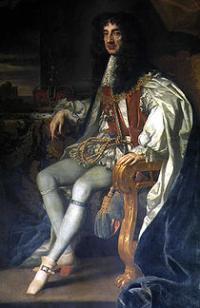|
|
|
Charles II (29 May 1630 OS � 6 February 1685 OS) was monarch of the three kingdoms of England, Scotland, and Ireland. Charles II's father, King Charles I, was executed at Whitehall on 30 January 1649, at the climax of the English Civil War. Although the Parliament of Scotland proclaimed Charles II King of Great Britain and Ireland in Edinburgh on 6 February 1649, the English Parliament instead passed a statute that made any such proclamation in England and Ireland unlawful. England entered the period known as the English Interregnum or the English Commonwealth, and the country was a de facto republic, led by Oliver Cromwell. Cromwell defeated Charles at the Battle of Worcester on 3 September 1651, and Charles fled to mainland Europe. Cromwell became virtual dictator of England, Scotland and Ireland. Charles spent the next nine years in exile in France, the United Provinces and the Spanish Netherlands. A political crisis that followed the death of Cromwell in 1658 resulted in the restoration of the monarchy, and Charles was invited to return to Britain. On 29 May 1660, his 30th birthday, he was received in London to public acclaim. After 1660, all legal documents were dated as if Charles had succeeded his father as king in 1649. Charles's English parliament enacted laws known as the Clarendon Code, designed to shore up the position of the re-established Church of England. Charles acquiesced to the Clarendon Code even though he himself favoured a policy of religious tolerance. The major foreign policy issue of Charles's early reign was the Second Anglo-Dutch War. In 1670, Charles entered into the secret treaty of Dover, an alliance with his first cousin King Louis XIV of France. Louis agreed to aid Charles in the Third Anglo-Dutch War and pay Charles a pension, and Charles secretly promised to convert to Roman Catholicism at an unspecified future date. Charles attempted to introduce religious freedom for Catholics and Protestant dissenters with his 1672 Royal Declaration of Indulgence, but the English Parliament forced him to withdraw it. In 1679, Titus Oates's revelations of a supposed "Popish Plot" sparked the Exclusion Crisis when it was revealed that Charles's brother and heir (James, Duke of York) was a Roman Catholic. The crisis saw the birth of the pro-exclusion Whig and anti-exclusion Tory parties. Charles sided with the Tories, and, following the discovery of the Rye House Plot to murder Charles and James in 1683, some Whig leaders were killed or forced into exile. Charles dissolved the English Parliament in 1681, and ruled alone until his death on 6 February 1685. He was received into the Roman Catholic Church on his deathbed. Charles was popularly known as the Merrie Monarch, in reference to both the liveliness and hedonism of his court and the general relief at the return to normality after over a decade of rule by Oliver Cromwell and the Puritans. Charles's wife, Catherine of Braganza, bore no children, but Charles acknowledged at least 12 illegitimate children by various mistresses. As illegitimate children were excluded from the succession, he was succeeded by his brother James. |




 RSS
RSS